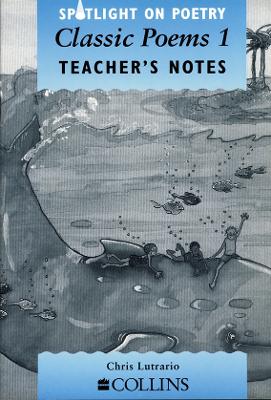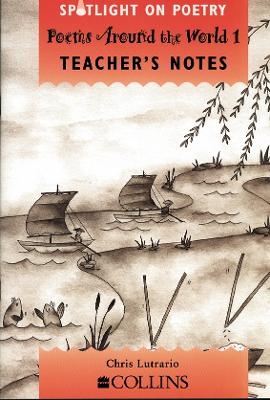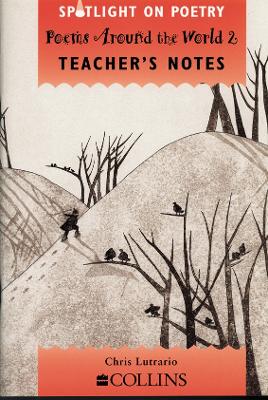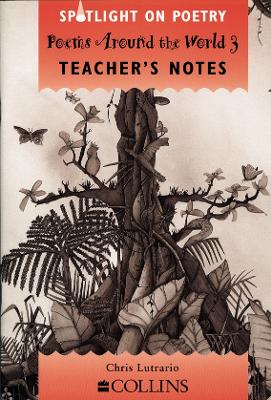Spotlight on Poetry
9 total works
The What Kind of Poem? collections feature a lively and diverse range of different poetic forms and styles. Each level is accompanied by Teacher’s Notes that link poems to objectives in the National Literacy Framework, providing creative teaching ideas and photocopiable Activity Masters. Level 3 links to objectives for Years 5 and 6.
The What Kind of Poem? collections feature a lively and diverse range of different poetic forms and styles including riddles, limericks, sonnets, haiku, cinquains, acrostics, epitaphs, shape poems, alphabet poems, conversations, diaries, monologues, lists, word play and poems that play with sound and invent new or nonsense words.
Each collection is available as both a pupil reader and as a Big Book. The readers contain all the material in the Big Book plus some additional material, for example additional poems or full versions of poems that appear as extracts in the Big Book.
There are 3 levels in each strand, corresponding to Years 1/2 , Years 3/4 and Years 5/6. The poems have been carefully chosen to appeal to the age ranges.
The collections meet the range of objectives for poetry and the National Literacy Strategy as specified in the Literacy Framework. They have been selected by David Orme and Brian Moses, two well-known children’s poets.
There are two other strands in the Spotlight on Poetry series: ‘Poems Around the World’, and ‘Classic Poems’.
Spotlight on Poetry: Classic Poems offers a balanced and varied collection of classic and traditional poems. Each level is accompanied by Teacher’s Notes that link poems to objectives in the National Literacy Framework, providing creative teaching ideas and photocopiable Activity Masters. Classic Poems 1 is linked to objectives for Year 1-2.
Classic Poems 1 Teacher’s Notes contains teaching ideas and support activities for the following poems:
The Elephant by Hilaire Belloc
One Potato, Two Potato (Trad)
Betty Botter (Trad)
She Sells Sea Shells (Trad)
The Tickle Rhyme (Ian Serraillier)
There was an Old Man (Edward Lear)
Solomon Grundy (Trad)
Caterpilar (Christina Rossetti)
Twinkle Twinkle Little Bat (Lewis Carroll)
The Star (Jane Taylor)
The Owl and the Pussy Cat (Edward Lear)
The Pancake (Christina Rossetti)
The Whale (Lord Alfred Douglas)
Hurt No Living Thing (Christina Rossetti)
Bed in Summer (Robert Louis Stevenson)
Some One (Walter De la Mare)
There are 3 levels in each strand, corresponding to Years 1/2 (Classic Poems 1), Years 3/4 (Classic Poems 2) and Years 5/6 (Classic Poems 3).
The poems have been carefully chosen to appeal to the age ranges.
The collections meet the range of objectives for poetry and the National Literacy Strategy as specified in the Literacy Framework. They have been selected by David Orme and Brian Moses, two well-known children’s poets.
There are two other strands in the Spotlight on Poetry series: ‘Poems Around the World’, and ‘What kind of Poem?’.
Spotlight on Poetry: Classic Poems offers a balanced and varied collection of classic and traditional poems. Each level is accompanied by Teacher’s Notes that link poems to objectives in the National Literacy Framework, providing creative teaching ideas and photocopiable Activity Masters. Classic Poems 3 is linked to objectives for Year 5-6.
Classic Poems 2 Teacher’s Notes contains teaching ideas and support activities.
There are 3 levels in each strand, corresponding to Years 1/2 (Classic Poems 1), Years 3/4 (Classic Poems 2) and Years 5/6 (Classic Poems 3).
The poems have been carefully chosen to appeal to the age ranges.
The collections meet the range of objectives for poetry and the National Literacy Strategy as specified in the Literacy Framework. They have been selected by David Orme and Brian Moses, two well-known children’s poets.
There are two other strands in the Spotlight on Poetry series: ‘Poems Around the World’, and ‘What kind of Poem?’.
The What Kind of Poem? collections feature a lively and diverse range of different poetic forms and styles. Each level is accompanied by Teacher’s Notes that link poems to objectives in the National Literacy Framework, providing creative teaching ideas and photocopiable Activity Masters. Level 2 links to objectives for Years 3 and 4.
The What Kind of Poem? collections feature a lively and diverse range of different poetic forms and styles including riddles, limericks, sonnets, haiku, cinquains, acrostics, epitaphs, shape poems, alphabet poems, conversations, diaries, monologues, lists, word play and poems that play with sound and invent new or nonsense words.
Each collection is available as both a pupil reader and as a Big Book. The readers contain all the material in the Big Book plus some additional material, for example additional poems or full versions of poems that appear as extracts in the Big Book.
There are 3 levels in each strand, corresponding to Years 1/2 , Years 3/4 and Years 5/6. The poems have been carefully chosen to appeal to the age ranges.
The collections meet the range of objectives for poetry and the National Literacy Strategy as specified in the Literacy Framework. They have been selected by David Orme and Brian Moses, two well-known children’s poets.
There are two other strands in the Spotlight on Poetry series: ‘Poems Around the World’, and ‘Classic Poems’.
The What Kind of Poem? collections feature a lively and diverse range of different poetic forms and styles. Each level is accompanied by Teacher’s Notes that link poems to objectives in the National Literacy Framework, providing creative teaching ideas and photocopiable Activity Masters. Level 1 links to objectives for Years 1 and 2.
The What Kind of Poem? collections feature a lively and diverse range of different poetic forms and styles including riddles, limericks, sonnets, haiku, cinquains, acrostics, epitaphs, shape poems, alphabet poems, conversations, diaries, monologues, lists, word play and poems that play with sound and invent new or nonsense words.
Each collection is available as both a pupil reader and as a Big Book. The readers contain all the material in the Big Book plus some additional material, for example additional poems or full versions of poems that appear as extracts in the Big Book.
There are 3 levels in each strand, corresponding to Years 1/2 , Years 3/4 and Years 5/6. The poems have been carefully chosen to appeal to the age ranges.
The collections meet the range of objectives for poetry and the National Literacy Strategy as specified in the Literacy Framework. They have been selected by David Orme and Brian Moses, two well-known children’s poets.
There are two other strands in the Spotlight on Poetry series: ‘Poems Around the World’, and ‘Classic Poems’.
Spotlight on Poetry: Poems Around the World provides three collections of modern and traditional poems from around the world. The Teacher’s Notes link poems to objectives in the National Literacy Framework, providing creative teaching ideas and photocopiable Activity Masters. Poems Around the World 1 is linked to objectives for Year 1 and 2.
The selections meets the range of objectives for poetry and the National Literacy Strategy as specified in the Literacy Framework.
The poems have been put together by David Orme and Brian Moses, two well-known children’s poets.
The Poems Around the World selection features poets such as John Agard, Valerie Bloom, James Berry and the work of many other poets from a variety of countries.
The poems have been carefully chosen to appeal to the age ranges. There are 3 levels in each strand, corresponding to KS1 (Poems Around the World 1), Years 3/4 (2), Years 5/6 (3).
Literacy selections include a Big Book for shared work and six readers for guided and independent work. The readers contain all the material in the Big Book plus some additional material e.g. extra poems or full versions of poems that appear as extracts in the Big Book.
Each level will be accompanied by Teacher’s Notes which match the poems to the NLF, provide teaching ideas and photocopiable Activity Masters.
There are two other strands in the Spotlight on Poetry series: Classic Poems and What kind of Poem?
Spotlight on Poetry: Poems Around the World provides three collections of modern and traditional poems from around the world. The Teacher’s Notes link poems to objectives in the National Literacy Framework, providing creative teaching ideas and photocopiable Activity Masters. Poems Around the World 1 is linked to objectives for Year 5 and 6.
The Poems Around the World selection features poets such as John Agard, Valerie Bloom, James Berry and the work of many other poets from a variety of countries. Each collection is available as both a pupil reader and as a Big Book. The readers contain all the material in the Big Book plus some additional material, for example additional poems or full versions of poems that appear as extracts in the Big Book.
Poems Around the World 3 contains the following poems:
Everybody Rap (Su Andi)
Poetry Jump-up (John Agard)
The Panther (Rainer Maria Rilke)
De (Valerie Bloom)
The River (Valerie Bloom)
Sensemaya: A Chant for Killing A Snake (Nicolas Guillen)
The Storm (Ashok B Raha)
Moon (Li Bai)
The Distant Talking Drum (Isaac Olaleye)
In the Garden (Rupendra Guha Majumdar)
Can You? (Nicolas Guillen)
The Picnic in Jammu (Zulfikar Ghose)
The Door (Miroslav Holub)
The Father’s Song (Anon – Inuit)
Isn’t my Name Magical? (James Berry)
The Dream Keeper (Langston Hughes)
There are 3 levels in each strand, corresponding to Years 1/2 (Poems Around the World 1), Years 3/4 (Poems Around the World 2) and Years 5/6 (Poems Around the World 3).
The poems have been carefully chosen to appeal to the age ranges.
The collections meet the range of objectives for poetry and the National Literacy Strategy as specified in the Literacy Framework. They have been selected by David Orme and Brian Moses, two well-known children’s poets.
Each level is accompanied by Teacher’s Notes that link poems to objectives in the National Literacy Framework, providing creative teaching ideas and photocopiable Activity Masters.
There are two other strands in the Spotlight on Poetry series: Classic Poems and What Kind of Poem?
Spotlight on Poetry: Classic Poems offers a balanced and varied collection of classic and traditional poems. Each level is accompanied by Teacher’s Notes that link poems to objectives in the National Literacy Framework, providing creative teaching ideas and photocopiable Activity Masters. Classic Poems 2 is linked to objectives for Year 3-4.
Classic Poems 2 Teacher’s Notes contains teaching ideas and support activities.
There are 3 levels in each strand, corresponding to Years 1/2 (Classic Poems 1), Years 3/4 (Classic Poems 2) and Years 5/6 (Classic Poems 3).
The poems have been carefully chosen to appeal to the age ranges.
The collections meet the range of objectives for poetry and the National Literacy Strategy as specified in the Literacy Framework. They have been selected by David Orme and Brian Moses, two well-known children’s poets.
There are two other strands in the Spotlight on Poetry series: ‘Poems Around the World’, and ‘What kind of Poem?’.






